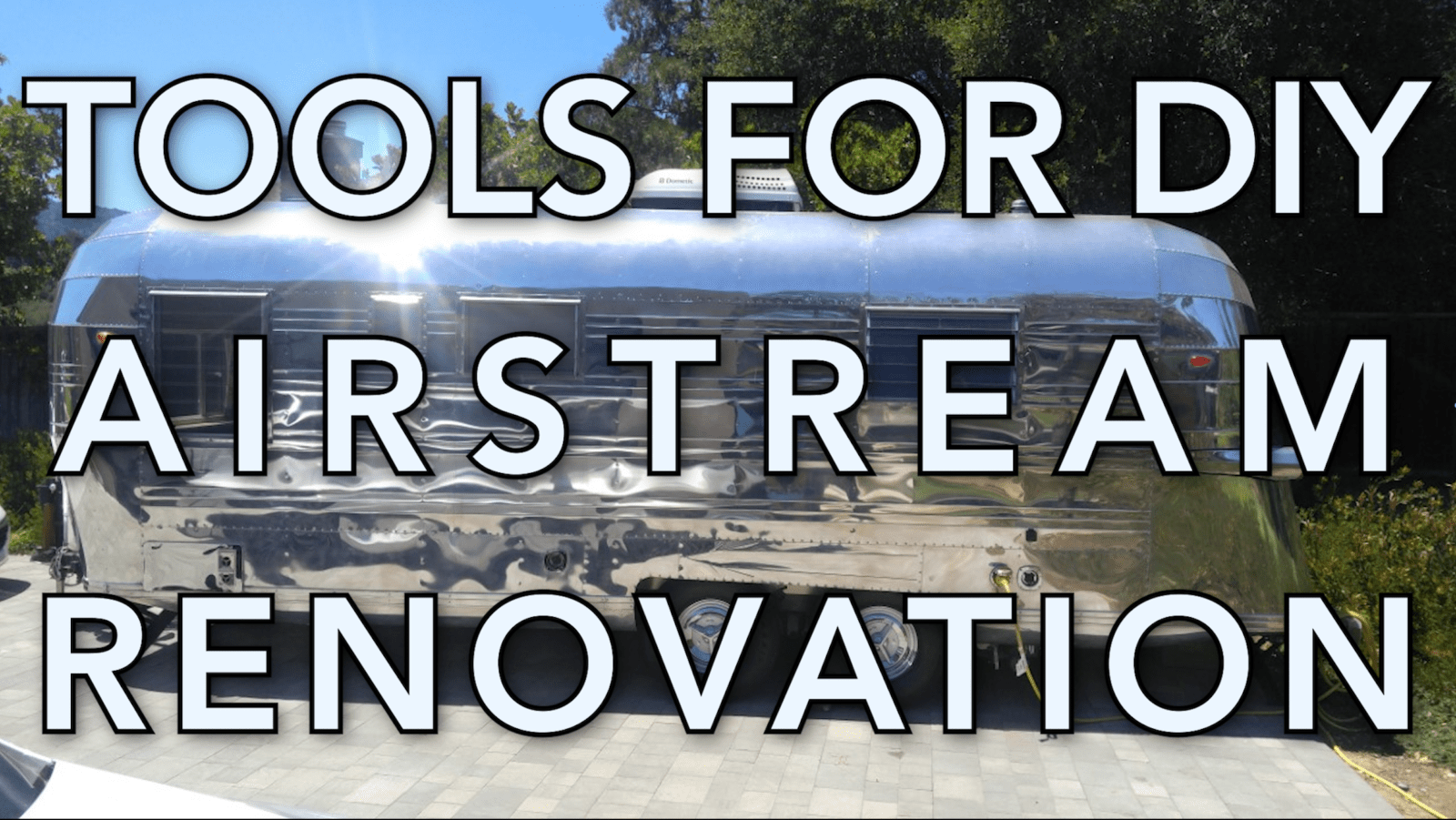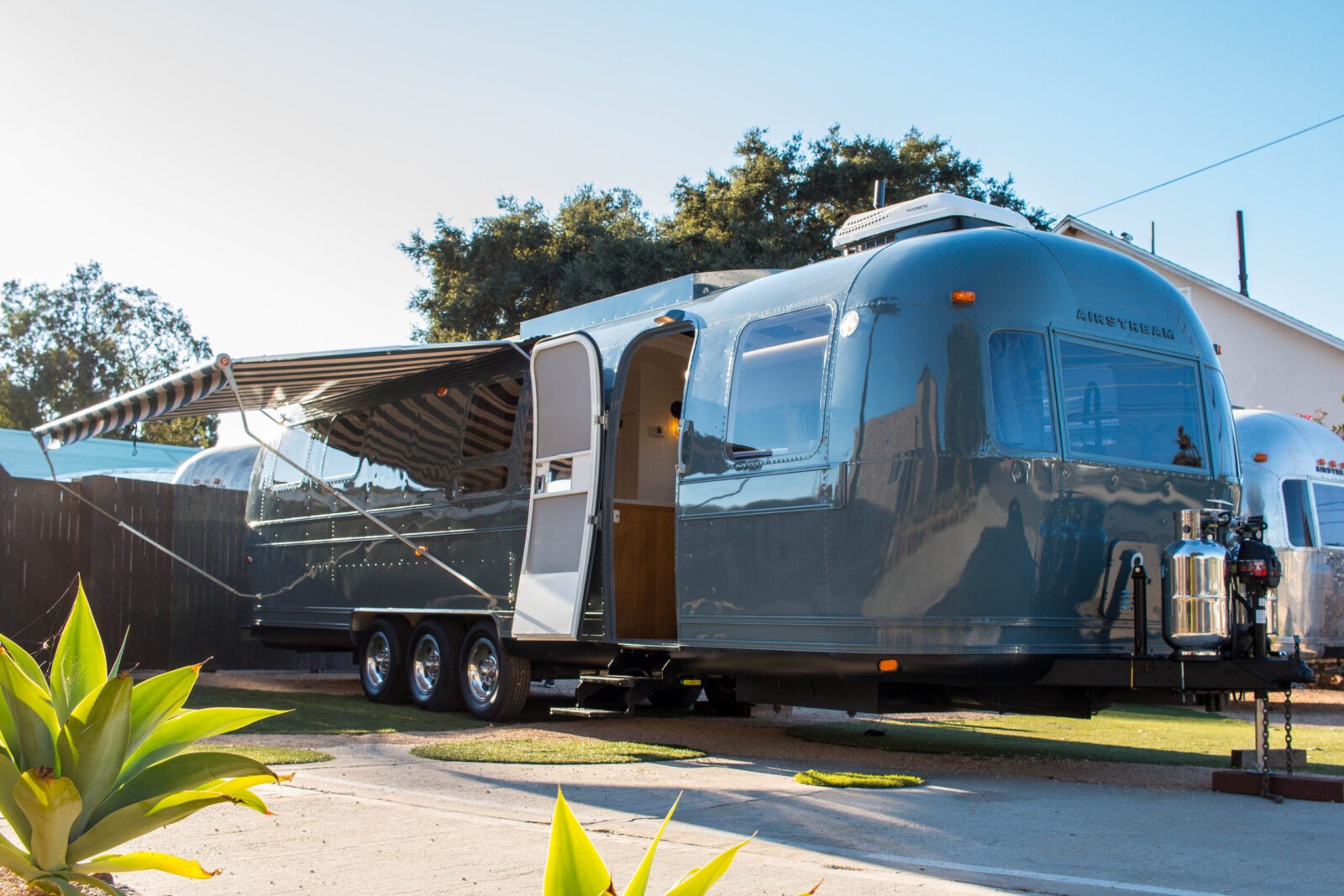Best Tools for DIY Airstream Renovations
Starting your own Airstream renovation but not sure what tools you need? Founder/Builder, Nate and his son, Teo share their recommendations for the best woodworking, metalworking, plumbing, and electrical tools to have in your DIY renovation toolkit along with tips and techniques to help you achieve the best results.
Grinders (0:39)
When it comes to grinders, it depends entirely on what you are working with. For thicker aluminum, corded grinders work better. Cordless grinders are convenient but are better suited for thinner aluminum, cut-off work, simple cuts, or shaving edges down.
Aluminum Cutting Techniques (1:11)
For cutting your aluminum, you can always go the classic way by hand-cutting with shears. There are right handed and left handed snips—with their handles colored red and green, respectively. The type of shears you use will determine which direction the metal is curling off as you cut. You will usually want to use right handed shears going counter-clockwise and left handed ones when going clockwise.
You can also use double cut shears, which will save you some effort, but will ultimately result in a rough cut. You also have to be wary that using a double cut can scar up the aluminum. In order to avoid this as much as possible, try to lean slightly away from the material that you want to keep.
Nibblers are another option—they function almost like a hole-punch. They are speedy and great for cutting curved edges. They do leave a slightly serrated edge on your material, so they are best for edges that will ultimately be covered or grinded.
Rivet Types and Uses (3:12)
When working with airstreams, you are mostly going to be using 1/8th inch and 5/32nd inch rivets. You will want to use a pop rivet for your interior and buck rivets on your exterior. In conjunction with those rivets, we use something really useful called a cleco which basically acts as a temporary rivet. With a cleco, you’ll need a cleco plier which compresses it, allows it to go through the hole, and then locks it in behind.
For our exterior rivets, we start by placing the solid buck rivet in the hole, with Sikaflex in the joint to make it waterproof and usually a little on your rivet tip. You’ll often find you need to hog out the hole just a little bit so that the buck rivet slips through. This is when you’ll need a second person. Once the front is all the way in the hole, you’ll need to compress the back with a bucking tool and an air gun. Press from the front and back and you will get a solid structural rivet.
Sealants and Caulk (6:39)
For caulking guns you have the old school hand-pull style and then you have your powered styles. This almost entirely comes down to preference. You’ll also want some Sikaflex which is a construction sealant that we use for all sorts of different things.
Mapping and Marking your Rivet Pattern (7:30)
To ensure your rivets are nice and clean, you may want to use a rivet template gauge also known as a rivet spacing fan which is an easy way to map out your pattern.
Aluminum Cutting Tools (8:07)
Hand-cutting your aluminum is always a pain. We take the easy way by using the break and 12’ shear in our shop.
Using Rivet Guns (8:46)
It’s always important to mind which head you are using and match it with your rivet. There are different heads for 1/8 inch and 5/32 inch.
Olympic rivets are what you would use if you cannot access the back of an exterior rivet and can be installed with one person. They should not be used exclusively as they are not as structurally solid as a buck rivet. When installing an olympic rivet, just pull until they pop. They will leave a little head sticking out, there are a few ways to deal with that. You can use dikes to cut it or you can feather it in with a grinder to make it smooth and then when you polish it it blends in.
Choosing your Drill Brand (10:44)
When choosing your tools, it is best to pick a brand and stick with it because your batteries will all be interchangeable. There are always exceptions, but it is a good rule of thumb.
Drills (11:15)
Some of your first investments should be a good drill and an impact driver—impacts drivers are crucial once you get into woodworking and setting screws.
Saws (11:33)
Most people are not going to have a full shop set-up with tables saws, luckily you can really make due with hand tools. Track saws are a great option if you want to avoid investing into a large table saw. They can be clamped to any surface and you can join the track together so it can extend up to 12 feet.
Scribing (12:56)
You will have noticed that just about everything in an airstream is curved. That’s why any airstream DIYer needs to learn how to scribe. You don’t need anything expensive to scribe, just a compass. Using your compass you can shape your wood to perfectly fit into curves.
More Saws (13:53)
When it comes to saws, your basics are going to be a jigsaw, a track saw, and a Miter saw.
Routers (14:04)
If you want to add some style to your build, routers are a great option. We use an 1/8th round-over all the time.
Nailing (14:26)
For nailing things together you have a few options, you can go with staples or pinnails. Micropinnailers are great for holding things in place while the glue sets, although not sturdy enough on their own.
PEX Plumbing (15:23)
Most of your plumbing will be done with PEX. For PEX pipe you need a PEX cutter, PEX rings, PEX fittings, and a PEX crimper. There are a couple ways to do the fitting–you can do it by hand or you can go automatic. The hand tool is going to be much cheaper, but it is entirely up to you. No matter how secure you think your fitting is, always make sure to water test it before stallation.
When you are doing your tanks in your plumbing, there are a few routes. Most people choose to order their tanks with the spinweld fittings in it rather than do it themselves. This is what we recommend unless you have had some time to practice on your own.
Electrical (17:40)
Your basic electrical tools are pretty simple. Voltmeters are always useful, especially for continuity testing. When you’re running wires, it’s a great way to find out if you’ve nicked your wires anywhere before you put everything together. You will also need some good wire strippers and a crimp tool.
P.S. One last thing: make sure you get a good straight edge!
Mentioned Tools
Innovative Spaces may, at no cost to you, earn a commission if you purchase products through these affiliate links.
METALWORK
- Cleco Pliers
- Standard Cleco Fasteners (1/8th)
- Standard Cleco Fasteners (5/32nd)
- Double Cut
- Nibbler
- Snip set
- Corded Grinder
- Cordless Grinder
- Cordless Caulk & Adhesive Gun
- Hand Caulking Gun
- Air Hammer
- Rivet Fan Spacing Tool
- Rivet Fan Spacer (Mini)
- Marson Hand Rivet Gun
- Bucking Tool
- Drill and Impact
WOODWORK
- Compact Router
- Headless Pins
- Gauge Micro Pin Nailer
- Cordless Jig Saw
- Woodworking Compass
- Compound Miter Saw
- Steel Bar Clamps
PLUMBING
ELECTRICAL
Don’t want to miss another tutorial from us?
Subscribe to receive our newsletter twice a month with in-depth DIY renovation tutorials, RV inspiration, and special offers!




